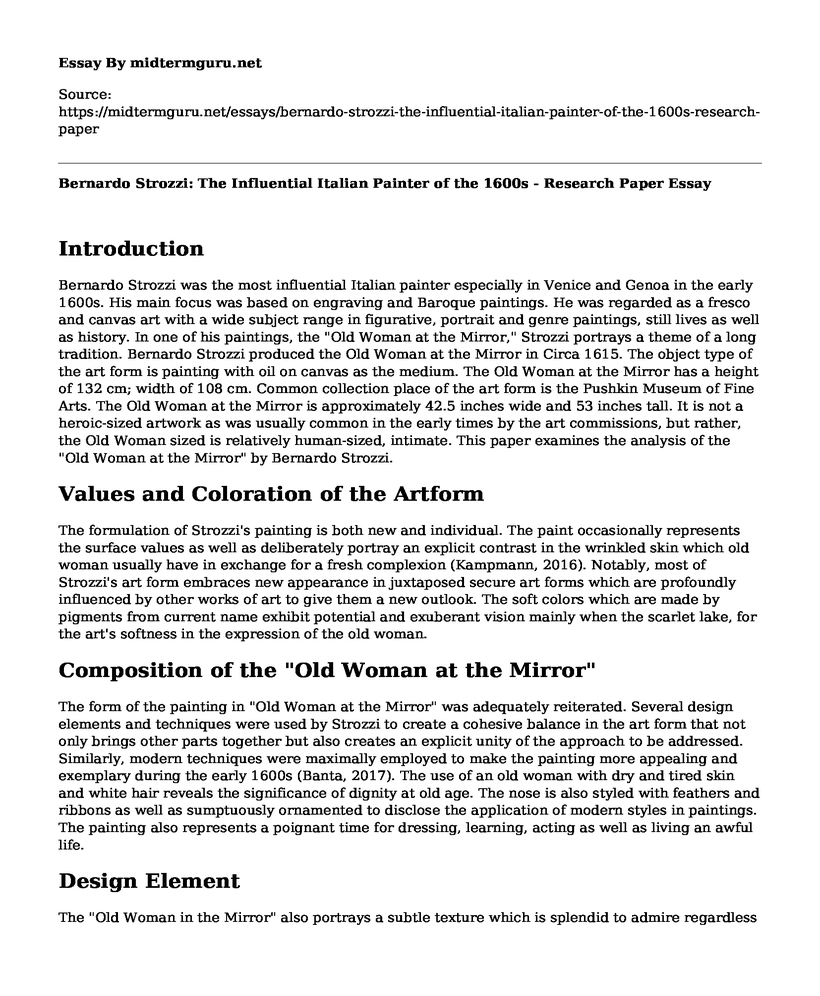Introduction
Bernardo Strozzi was the most influential Italian painter especially in Venice and Genoa in the early 1600s. His main focus was based on engraving and Baroque paintings. He was regarded as a fresco and canvas art with a wide subject range in figurative, portrait and genre paintings, still lives as well as history. In one of his paintings, the "Old Woman at the Mirror," Strozzi portrays a theme of a long tradition. Bernardo Strozzi produced the Old Woman at the Mirror in Circa 1615. The object type of the art form is painting with oil on canvas as the medium. The Old Woman at the Mirror has a height of 132 cm; width of 108 cm. Common collection place of the art form is the Pushkin Museum of Fine Arts. The Old Woman at the Mirror is approximately 42.5 inches wide and 53 inches tall. It is not a heroic-sized artwork as was usually common in the early times by the art commissions, but rather, the Old Woman sized is relatively human-sized, intimate. This paper examines the analysis of the "Old Woman at the Mirror" by Bernardo Strozzi.
Values and Coloration of the Artform
The formulation of Strozzi's painting is both new and individual. The paint occasionally represents the surface values as well as deliberately portray an explicit contrast in the wrinkled skin which old woman usually have in exchange for a fresh complexion (Kampmann, 2016). Notably, most of Strozzi's art form embraces new appearance in juxtaposed secure art forms which are profoundly influenced by other works of art to give them a new outlook. The soft colors which are made by pigments from current name exhibit potential and exuberant vision mainly when the scarlet lake, for the art's softness in the expression of the old woman.
Composition of the "Old Woman at the Mirror"
The form of the painting in "Old Woman at the Mirror" was adequately reiterated. Several design elements and techniques were used by Strozzi to create a cohesive balance in the art form that not only brings other parts together but also creates an explicit unity of the approach to be addressed. Similarly, modern techniques were maximally employed to make the painting more appealing and exemplary during the early 1600s (Banta, 2017). The use of an old woman with dry and tired skin and white hair reveals the significance of dignity at old age. The nose is also styled with feathers and ribbons as well as sumptuously ornamented to disclose the application of modern styles in paintings. The painting also represents a poignant time for dressing, learning, acting as well as living an awful life.
Design Element
The "Old Woman in the Mirror" also portrays a subtle texture which is splendid to admire regardless of the age factor which is presented in the mirror. Banta (2017), Strozzi uses human size to give meaning to his painting which was adversely common during the period in which the painting was done for the satisfaction of theme of tradition (Banta, 2017). The mixture of different colors gave the picture a pleasant outlook, though several meanings were associated with each color used. The value, lightness or darkness of the color used shaped the tonal contrast as well as other principles of design. The use of feathered fan portrays boldness which is shared among women of certain caliber who are agitated to learn more her life.
Conclusion
In conclusion, the Old Woman in the Mirror also reveals the nature of women, especially amidst challenges. Strozzi coined the painting from her mother to explain how steadfast someone can be through different challenges that he or she is exposed to in his or her life. However, the determined meaning of the painting, the "Old Woman at the Mirror" by Bernardo Strozzi aimed at revealing the long lost tradition.
References
Banta, A. B. (2017). "Il Prete Genovese": Bernardo Strozzi and the Venetian Cinquecento. The Enduring Legacy of Venetian Renaissance Art (pp. 45-60). Routledge.
Kampmann, S. (2016). Visual Aging Studies: Exploring Images of Aging in Art History and Other Disciplines. Age, Culture, Humanities, 2, 279-291.
Cite this page
Bernardo Strozzi: The Influential Italian Painter of the 1600s - Research Paper. (2022, Dec 28). Retrieved from https://midtermguru.com/essays/bernardo-strozzi-the-influential-italian-painter-of-the-1600s-research-paper
If you are the original author of this essay and no longer wish to have it published on the midtermguru.com website, please click below to request its removal:
- The Mysteries of the Egyptian Art, Pyramids and Architecture - Essay Sample
- Relationship Between Fashion and Nostalgia - Paper Example
- Literary Analysis Essay on Battle Cry of Freedom
- Couples Conflict: TV vs. Online Gaming - Essay Sample
- The Inequality of Blacks: A Long History of Discrimination - Essay Sample
- Recent Trends in Health Care Sector: Indian Perspective - Research Paper
- The Great Depression of 1933: A Tale of Woe and Loss - Essay Sample







